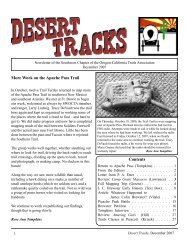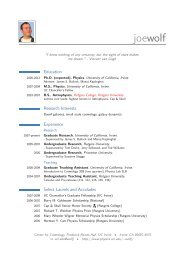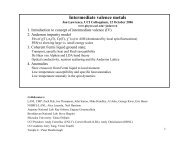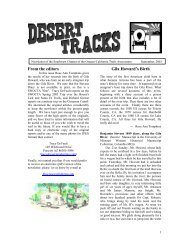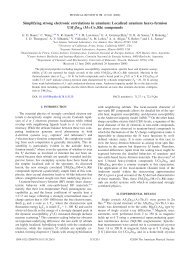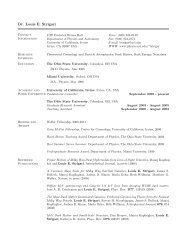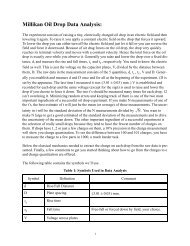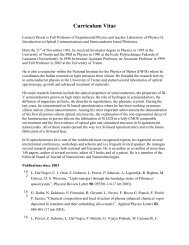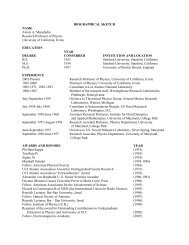Reading the Blueprints of Creation
Reading the Blueprints of Creation
Reading the Blueprints of Creation
You also want an ePaper? Increase the reach of your titles
YUMPU automatically turns print PDFs into web optimized ePapers that Google loves.
SPECIAL REPORT<br />
R<br />
By<br />
EADING THE BLUEPRINTS<br />
<strong>of</strong> CREATION<br />
Michael A. Strauss<br />
The latest maps <strong>of</strong> <strong>the</strong> cosmos have surveyed hundreds <strong>of</strong> thousands<br />
<strong>of</strong> galaxies, whose clustering has grown from primordial fluctuations<br />
As late as <strong>the</strong> 1970s, cosmology, <strong>the</strong> study <strong>of</strong> <strong>the</strong> universe<br />
as a whole, was a field filled with much speculation<br />
but few hard facts. New observations and<br />
<strong>the</strong>oretical work over <strong>the</strong> past two decades have changed that<br />
dramatically. Cosmology has become a rigorous, quantitative<br />
branch <strong>of</strong> astrophysics with a strong <strong>the</strong>oretical foundation<br />
backed by abundant data. The big bang model, which states<br />
that almost 14 billion years ago <strong>the</strong> universe started expanding<br />
from a state <strong>of</strong> extremely high density and temperature, is able<br />
to explain galaxy motions, <strong>the</strong> abundance <strong>of</strong> hydrogen and helium,<br />
and <strong>the</strong> properties <strong>of</strong> <strong>the</strong> cosmic microwave background<br />
(CMB), <strong>the</strong> remnant heat from <strong>the</strong> expanding and cooling gas.<br />
Cosmologists can now go to <strong>the</strong> next level and claim an understanding<br />
<strong>of</strong> <strong>the</strong> formation <strong>of</strong> structures in <strong>the</strong> universe. Measurements<br />
<strong>of</strong> <strong>the</strong> large-scale distribution <strong>of</strong> galaxies, as mapped<br />
by cartography projects such as <strong>the</strong> ongoing Sloan Digital Sky<br />
Survey (SDSS), are in beautiful agreement with <strong>the</strong>oretical predictions.<br />
We currently have a coherent model that tracks <strong>the</strong><br />
growth <strong>of</strong> subtle density fluctuations laid down in <strong>the</strong> early universe<br />
to <strong>the</strong> present richness <strong>of</strong> <strong>the</strong> night sky.<br />
The universe around us exhibits structure on all scales. Stars<br />
are not scattered uniformly through space; <strong>the</strong>y are grouped<br />
into galaxies. Our sun is one <strong>of</strong> several hundred billion stars in<br />
<strong>the</strong> Milky Way galaxy, a highly flattened disk 100,000 lightyears<br />
across. The Milky Way, in turn, is one <strong>of</strong> tens <strong>of</strong> billions<br />
<strong>of</strong> galaxies in <strong>the</strong> observable universe. Our nearest large galactic<br />
neighbor is about two million light-years away. But galaxies<br />
are not randomly sprinkled like raisins in a muffin. Between<br />
5 and 10 percent are grouped into clusters containing up to<br />
1,000 galaxies in a volume a few million light-years across.<br />
Most astronomers used to think that galaxy clusters were<br />
<strong>the</strong> largest coherent structures in existence. Whereas stars belong<br />
to galaxies and many galaxies belong to clusters, <strong>the</strong> clusters<br />
did not seem to be clumped into larger bodies. This picture<br />
fit neatly with <strong>the</strong>orists’ understanding <strong>of</strong> <strong>the</strong> big bang. When<br />
Einstein first applied his general <strong>the</strong>ory <strong>of</strong> relativity to <strong>the</strong> universe,<br />
he made a dramatic simplifying assumption: <strong>the</strong> universe,<br />
on average, was homogeneous (it had no big lumps) and<br />
isotropic (it looked <strong>the</strong> same in all directions). He called this assumption<br />
<strong>the</strong> cosmological principle, and it underlies all modern<br />
scientific models <strong>of</strong> <strong>the</strong> universe.<br />
Becoming Aware <strong>of</strong> Large Structures<br />
T E S T I N G W H E T H E R <strong>the</strong> principle applies beyond galaxy<br />
clusters requires some depth perception. When you point a telescope<br />
at <strong>the</strong> night sky, <strong>the</strong> eyepiece reveals stars, planets and<br />
galaxies. But without fur<strong>the</strong>r information, you will not know<br />
which objects are small and nearby or large and far away. Fortunately,<br />
<strong>the</strong> telescope can provide that information. For galaxies,<br />
<strong>the</strong> key is that we live in an expanding universe. Galaxies<br />
are receding from one ano<strong>the</strong>r, and <strong>the</strong> more distant a galaxy<br />
is, <strong>the</strong> faster it is moving away from us. This motion manifests<br />
itself as a redshift in <strong>the</strong> spectrum <strong>of</strong> <strong>the</strong> galaxy. The energy <strong>of</strong><br />
its photons decreases (shifts in wavelength from blue to red) by<br />
an amount that depends on its distance. Having established this<br />
relation for objects <strong>of</strong> known distance, researchers use it to<br />
study galaxies <strong>of</strong> unknown distance. They obtain <strong>the</strong>ir spectra,<br />
THE UNIVERSE IS HIGHLY STRUCTURED on scales up to a billion light-years<br />
or so. Matter is not randomly scattered; gravity has organized it.<br />
D A V I D E M M I T E P H O T O G R A P H Y<br />
54 S C I E N T I F I C A M E R I C A N F E B R U A R Y 2 0 0 4<br />
COPYRIGHT 2004 SCIENTIFIC AMERICAN, INC.
COPYRIGHT 2004 SCIENTIFIC AMERICAN, INC.
determine <strong>the</strong>ir redshifts and infer how far away <strong>the</strong>y are.<br />
By <strong>the</strong> late 1970s, advances in telescope and detector technology<br />
made it feasible to carry out extensive redshift surveys<br />
<strong>of</strong> galaxies to create three-dimensional maps <strong>of</strong> <strong>the</strong> local cosmos.<br />
As a junior in college, I read a Scientific American article<br />
by Stephen A. Gregory and Laird A. Thompson [“Superclusters<br />
and Voids in <strong>the</strong> Distribution <strong>of</strong> Galaxies,” March 1982]<br />
that detailed some <strong>of</strong> <strong>the</strong>se first 3-D maps. The authors described<br />
hints that Einstein’s cosmological principle might be<br />
wrong: <strong>the</strong> discovery <strong>of</strong> coherent structures that were much<br />
larger than single clusters, and great voids many tens <strong>of</strong> millions<br />
<strong>of</strong> light-years across. I was fascinated. This exercise in cosmography,<br />
in discovering entirely new structures in <strong>the</strong> universe,<br />
struck me as one <strong>of</strong> <strong>the</strong> most exciting things happening<br />
in science, and it led me to my present career.<br />
In 1986 Valérie de Lapparent, Margaret J. Geller and John<br />
P. Huchra <strong>of</strong> <strong>the</strong> Harvard-Smithsonian Center for Astrophysics<br />
(CfA) published a map <strong>of</strong> <strong>the</strong> distribution <strong>of</strong> 1,100 galaxies, out<br />
<strong>of</strong> what eventually would be a survey containing 18,000 galaxies.<br />
This survey confirmed <strong>the</strong> richness and ubiquity <strong>of</strong> large<br />
structures. It revealed an unmistakably frothy appearance to<br />
<strong>the</strong> galaxy distribution; galaxies were located along filaments,<br />
leaving enormous voids. Among <strong>the</strong> map’s most notable features<br />
was a structure dubbed <strong>the</strong> Great Wall, which stretched<br />
700 million light-years from one edge <strong>of</strong> <strong>the</strong> surveyed region to<br />
<strong>the</strong> o<strong>the</strong>r. Given that <strong>the</strong> map did not reveal its end, <strong>the</strong> full extent<br />
<strong>of</strong> <strong>the</strong> wall was unknown.<br />
The presence <strong>of</strong> <strong>the</strong> Great Wall and <strong>the</strong> uncertainty about<br />
its extent added to <strong>the</strong> suspicion that <strong>the</strong> cosmological principle,<br />
and <strong>the</strong>refore our basic <strong>the</strong>oretical underpinning <strong>of</strong> <strong>the</strong> expanding<br />
universe, might be incorrect. Was Einstein wrong?<br />
Was <strong>the</strong> universe not homogeneous on average? It was clear<br />
that we needed to survey larger volumes to find out.<br />
The big bang paradigm holds that <strong>the</strong> structure we see in<br />
galaxy distribution today grew out <strong>of</strong> variations present in <strong>the</strong><br />
almost perfectly smooth early universe. These initial fluctuations<br />
were subtle; <strong>the</strong> density typically varied from one region<br />
Overview/Cosmic Structure<br />
■ Astronomers, acting as cosmic cartographers, are<br />
creating ever more detailed three-dimensional maps <strong>of</strong><br />
<strong>the</strong> locations <strong>of</strong> galaxies and galaxy clusters. The largest<br />
<strong>of</strong> <strong>the</strong>se projects, <strong>the</strong> Sloan Digital Sky Survey, is plotting<br />
a total <strong>of</strong> one million galaxies out to a distance <strong>of</strong> two<br />
billion light-years.<br />
■ The maps show that galaxies are organized into huge<br />
structures, stretching hundreds <strong>of</strong> millions <strong>of</strong> light-years.<br />
These surveys have quantified <strong>the</strong> degree <strong>of</strong> clustering to<br />
high precision. The results agree with <strong>the</strong> clustering<br />
expected from extrapolating <strong>the</strong> cosmic microwave background<br />
(CMB) fluctuations to <strong>the</strong> present. The agreement<br />
indicates that astronomers finally have a consistent<br />
account <strong>of</strong> 14 billion years <strong>of</strong> cosmic evolution.<br />
to ano<strong>the</strong>r by only one part in 100,000, as measured in <strong>the</strong> temperature<br />
<strong>of</strong> <strong>the</strong> cosmic microwave background [see “The Cosmic<br />
Symphony,” by Wayne Hu and Martin White, on page<br />
44]. If a region <strong>of</strong> space had a density higher than <strong>the</strong> average,<br />
it had a greater gravitational pull, and thus matter in its vicinity<br />
was drawn into it. Similarly, a region <strong>of</strong> space that was<br />
slightly less dense than average lost mass with time. Through<br />
this process <strong>of</strong> gravitational instability, <strong>the</strong> denser regions eventually<br />
became <strong>the</strong> huge galactic superclusters we see today; <strong>the</strong><br />
less dense regions became <strong>the</strong> vast empty voids.<br />
Running Hot and Cold<br />
A B O U T T H E T I M E <strong>the</strong> early redshift surveys were completed,<br />
astronomers realized that <strong>the</strong> story had a twist: <strong>the</strong> stars and<br />
gas we see in galaxies represent just a small fraction (about 2<br />
percent) <strong>of</strong> <strong>the</strong> total matter in <strong>the</strong> universe. The rest <strong>of</strong> <strong>the</strong> matter<br />
is revealed indirectly through its gravitational effects. Astronomers<br />
proposed a variety <strong>of</strong> models to describe this dark<br />
matter. These fell into two broad categories, cold and hot, and<br />
<strong>the</strong> difference is crucial to <strong>the</strong> evolution <strong>of</strong> structure.<br />
In <strong>the</strong> cold dark matter scenario, suggested by P. James E.<br />
Peebles <strong>of</strong> Princeton University and o<strong>the</strong>rs, <strong>the</strong> first structures to<br />
form were relatively small objects such as galaxies and pieces<br />
<strong>of</strong> galaxies. As time went on, gravity brought <strong>the</strong>se toge<strong>the</strong>r in<br />
ever larger structures. In this model, <strong>the</strong> Great Wall formed relatively<br />
recently. In <strong>the</strong> hot dark matter scenario, posited by<br />
Yakov B. Zel’dovich and his colleagues at Moscow State University,<br />
dark matter moved sufficiently quickly in <strong>the</strong> early universe<br />
to smooth out any clustering on small scales. The first<br />
things to form were large sheets and filaments tens or hundreds<br />
<strong>of</strong> millions <strong>of</strong> light-years in extent, which only later fragmented<br />
to form galaxies. In o<strong>the</strong>r words, <strong>the</strong> Great Wall is ancient.<br />
Thus, <strong>the</strong> next generation <strong>of</strong> surveys would not just test Einstein’s<br />
cosmological principle and identify <strong>the</strong> largest structures<br />
in <strong>the</strong> universe; it would also probe <strong>the</strong> nature <strong>of</strong> dark matter.<br />
One such survey was conducted from 1988 to 1994 by Stephen<br />
A. Shectman <strong>of</strong> <strong>the</strong> Carnegie Institution <strong>of</strong> Washington and his<br />
collaborators using <strong>the</strong> Las Campanas 2.5-meter telescope in<br />
Chile [see “Mapping <strong>the</strong> Universe,” by Stephen D. Landy; Scientific<br />
American, June 1999]. The survey contained 26,418<br />
galaxy redshifts and covered an appreciably larger volume than<br />
<strong>the</strong> original CfA survey. As team member Robert P. Kirshner<br />
<strong>of</strong> <strong>the</strong> CfA phrased it, <strong>the</strong> Las Campanas survey found “<strong>the</strong> end<br />
<strong>of</strong> greatness.” It revealed a galaxy distribution similar to that<br />
<strong>of</strong> <strong>the</strong> CfA survey but saw no structures much larger than <strong>the</strong><br />
Great Wall. Einstein’s cosmological principle appeared to hold:<br />
<strong>the</strong> cosmos is homogeneous and isotropic over vast distances.<br />
The Las Campanas survey was still not large enough to be<br />
definitive, however. It said nothing about what was happening<br />
in regions <strong>of</strong> space one to two billion light-years across. It<br />
is on <strong>the</strong>se largest scales that clustering is <strong>the</strong> easiest to interpret<br />
<strong>the</strong>oretically yet <strong>the</strong> hardest to measure observationally. The<br />
variations in galaxy numbers over such a volume are subtle, and<br />
it is easy to introduce errors into <strong>the</strong> sample; artifacts <strong>of</strong> <strong>the</strong> selection<br />
procedure might masquerade as clustering.<br />
56 S C I E N T I F I C A M E R I C A N F E B R U A R Y 2 0 0 4<br />
COPYRIGHT 2004 SCIENTIFIC AMERICAN, INC.
HOW TO SURVEY THE COSMOS IN FOUR NOT-SO-EASY STEPS<br />
THE SLOAN DIGITAL SKY SURVEY, <strong>the</strong> most advanced <strong>of</strong> <strong>the</strong> current generation <strong>of</strong> astronomical surveys, is compiling an atlas<br />
<strong>of</strong> a quarter <strong>of</strong> <strong>the</strong> sky. It will take five years, using a dedicated 2.5-meter telescope atop Apache Point in New Mexico.<br />
1<br />
2<br />
THE TELESCOPE operates in camera mode on clear nights, taking<br />
pictures through five color filters at <strong>the</strong> rate <strong>of</strong> 20 square degrees<br />
an hour—netting millions <strong>of</strong> celestial bodies per night.<br />
GALAXIES and o<strong>the</strong>r objects are identified by s<strong>of</strong>tware and<br />
selected for follow-up spectroscopy. The object shown here<br />
is <strong>the</strong> spiral galaxy UGC 03214 in <strong>the</strong> constellation Orion.<br />
3 1.0 4<br />
0.8<br />
Relative Flux<br />
0.6<br />
0.4<br />
0.2<br />
S D S S C O L L A B O R A T I O N<br />
OPTICAL FIBERS are plugged into a metal plate with 640 holes.<br />
Each fiber channels light from a celestial body to a spectrograph,<br />
which operates when <strong>the</strong> sky is not so clear.<br />
0<br />
400 600 800<br />
Wavelength (nanometers)<br />
THE SPECTRA THAT RESULT provide a precise way to classify<br />
objects. From <strong>the</strong>m, astronomers also determine <strong>the</strong><br />
redshifts, hence distances, <strong>of</strong> <strong>the</strong> objects.<br />
w w w . s c i a m . c o m S C I E N T I F I C A M E R I C A N 57<br />
COPYRIGHT 2004 SCIENTIFIC AMERICAN, INC.
COSMIC MAPS<br />
THESE WEDGE-SHAPED FIGURES show <strong>the</strong> distribution <strong>of</strong> galaxies (dots) in two volumes <strong>of</strong> space. The third<br />
dimension, which spans an angle <strong>of</strong> several degrees, has been flattened. The figures reveal two dramatic<br />
“Great Walls” containing thousands <strong>of</strong> galaxies each, as well as filaments and voids at all scales.<br />
Millions <strong>of</strong> Light-Years<br />
600 500 400 300 200 100<br />
MILKY WAY<br />
1,732 Galaxies<br />
REDSHIFT SURVEY by <strong>the</strong><br />
Harvard-Smithsonian Center<br />
for Astrophysics (CfA) in <strong>the</strong><br />
mid-1980s discovered <strong>the</strong> first<br />
Great Wall but was too limited<br />
to apprehend its full extent.<br />
9h<br />
16h<br />
CFA GREAT WALL<br />
1,200 1,100 1,000 900 800 700<br />
9h<br />
Millions <strong>of</strong> Light-Years<br />
10h<br />
10h<br />
SLOAN DIGITAL SKY SURVEY, which is<br />
now under way, covers a much larger<br />
volume. It found ano<strong>the</strong>r Great Wall<br />
more than one billion light-years<br />
long. The region shown above is<br />
about 1 percent <strong>of</strong> <strong>the</strong> full Sloan<br />
volume. The bull’s-eye diagram<br />
(right) covers a volume six times as<br />
large; <strong>the</strong> outline indicates <strong>the</strong><br />
location <strong>of</strong> <strong>the</strong> above wedge. The<br />
concentric circles indicate distance<br />
in millions <strong>of</strong> light-years.<br />
11h<br />
11h<br />
12h<br />
13h<br />
14h<br />
Location in Sky<br />
(right ascension, in hours)<br />
12h<br />
12h<br />
10h<br />
14h<br />
15h<br />
8h<br />
16h<br />
11,246 Galaxies<br />
13h<br />
14h<br />
SLOAN GREAT WALL<br />
6h<br />
4h<br />
2,000<br />
1,500<br />
2h<br />
1,000<br />
500<br />
0h<br />
22h<br />
20h<br />
18h<br />
52,561 Galaxies<br />
B R Y A N C H R I S T I E D E S I G N ; S O U R C E S : J . R I C H A R D G O T T A N D M A R I O J U R I C P r i n c e t o n U n i v e r s i t y ( w e d g e ) ; S D S S C O L L A B O R A T I O N ( b u l l ’ s - e y e )<br />
58 S C I E N T I F I C A M E R I C A N F E B R U A R Y 2 0 0 4<br />
COPYRIGHT 2004 SCIENTIFIC AMERICAN, INC.
OVERALL DISTRIBUTION OF COSMIC STRUCTURE<br />
THE MAPS produced by galaxy<br />
surveys can be boiled down to a<br />
power spectrum, which shows <strong>the</strong><br />
fractional density variation (vertical<br />
axis) from one position to ano<strong>the</strong>r in<br />
regions <strong>of</strong> different sizes (horizontal<br />
axis). O<strong>the</strong>r data—cosmic microwave<br />
background, gravitational lensing,<br />
galaxy-cluster surveys, hydrogen<br />
gas clouds—can be plotted in <strong>the</strong><br />
same way. They follow <strong>the</strong> same<br />
universal curve (solid line).<br />
The relative fluctuations approach<br />
zero, substantiating Einstein’s<br />
cosmological principle. The arrows<br />
represent upper limits.<br />
Relative Strength <strong>of</strong> Density Fluctuations<br />
10<br />
1.0<br />
0.1<br />
0.01<br />
0.001<br />
Gravitational<br />
lensing<br />
Intergalactic gas clumping<br />
Cluster abundance<br />
Galaxy clumping<br />
Cosmic<br />
microwave<br />
background<br />
0.0001<br />
10 100 1,000<br />
10,000 100,000<br />
Scale (millions <strong>of</strong> light-years)<br />
B R Y A N C H R I S T I E D E S I G N ; S O U R C E : S L O A N D I G I T A L S K Y S U R V E Y<br />
Astronomers, for example, typically choose all galaxies<br />
brighter than a certain value to be included in a given redshift<br />
survey. If <strong>the</strong>y overestimate galaxy brightnesses in one part <strong>of</strong><br />
<strong>the</strong> sky, <strong>the</strong> sample will have too many galaxies in that region,<br />
yielding a false measurement <strong>of</strong> clustering. Thus, a definitive<br />
redshift survey must not only cover a huge volume, it must be<br />
exquisitely calibrated.<br />
On a Clear Night. . .<br />
IN THE LATE 1980S James E. Gunn <strong>of</strong> Princeton, Richard<br />
G. Kron and Donald G. York <strong>of</strong> <strong>the</strong> University <strong>of</strong> Chicago and<br />
o<strong>the</strong>rs began a collaboration to do <strong>the</strong> problem right. That is,<br />
<strong>the</strong>y sought to measure <strong>the</strong> distribution <strong>of</strong> galaxies in <strong>the</strong> largest<br />
volume to date, with careful control <strong>of</strong> calibration. About a<br />
decade later <strong>the</strong> Sloan Digital Sky Survey, an $80-million, 200-<br />
astronomer collaboration, started operation. The SDSS features<br />
a special-purpose telescope with a 2.5-meter-wide primary mirror.<br />
The telescope operates in two modes. On <strong>the</strong> most pristine<br />
nights, it uses a wide-field camera to take carefully calibrated<br />
pictures <strong>of</strong> <strong>the</strong> night sky in five broad wavebands. The camera<br />
uses CCDs, highly sensitive electronic detectors whose response<br />
can be calibrated with an accuracy <strong>of</strong> 1 percent.<br />
On nights with moonshine or mild cloud cover, <strong>the</strong> telescope<br />
instead uses a pair <strong>of</strong> spectrographs to obtain spectra, and<br />
<strong>the</strong>refore redshifts, <strong>of</strong> 608 objects at a time. For reference, <strong>the</strong><br />
device also takes spectra <strong>of</strong> 32 blank patches <strong>of</strong> sky. Unlike traditional<br />
telescopes, for which nights are parceled out among<br />
many scientific programs, this telescope is devoted solely to <strong>the</strong><br />
survey, every night for five years. The project is now approaching<br />
<strong>the</strong> halfway point in its goal <strong>of</strong> measuring one million<br />
galaxy and quasar redshifts. As a midterm report, my colleagues<br />
and I recently completed an analysis <strong>of</strong> <strong>the</strong> first 200,000<br />
galaxies with redshifts.<br />
In a parallel effort, a team <strong>of</strong> Australian and British astronomers<br />
built a spectrograph for <strong>the</strong> 3.9-meter Anglo-Australian<br />
Telescope, capable <strong>of</strong> measuring <strong>the</strong> spectra <strong>of</strong> 400 objects<br />
at a time over a field <strong>of</strong> view two degrees on a side (thus<br />
earning <strong>the</strong> name “Two Degree Field,” or 2dF). The 2dF team<br />
worked from galaxy catalogues drawn from carefully calibrated<br />
and electronically scanned photographic atlases that were<br />
already available. Now complete, <strong>the</strong> survey measured <strong>the</strong> redshifts<br />
<strong>of</strong> 221,414 galaxies over a period <strong>of</strong> five years.<br />
Our surveys describe <strong>the</strong> distribution <strong>of</strong> galaxies. They do<br />
not see dark matter, which constitutes <strong>the</strong> bulk <strong>of</strong> <strong>the</strong> mass <strong>of</strong><br />
<strong>the</strong> universe. Researchers have no reason to assume that <strong>the</strong> distribution<br />
<strong>of</strong> galaxies is <strong>the</strong> same as <strong>the</strong> distribution <strong>of</strong> dark matter.<br />
For example, galaxies might tend to form only in regions<br />
that contain an above-average density <strong>of</strong> dark matter—a scenario<br />
astronomers refer to as biasing.<br />
By analyzing previous generations <strong>of</strong> redshift surveys, my<br />
colleagues and I had shown that <strong>the</strong> galaxy and dark matter distributions<br />
were closely related, but we were unable to distinguish<br />
between simple models <strong>of</strong> bias and <strong>the</strong> unbiased case.<br />
More recently Licia Verde <strong>of</strong> <strong>the</strong> University <strong>of</strong> Pennsylvania and<br />
her colleagues used <strong>the</strong> 2dF galaxy redshift survey to measure<br />
triplets <strong>of</strong> galaxies. It turns out that <strong>the</strong> number <strong>of</strong> <strong>the</strong>se trios<br />
T H E A U T H O R<br />
MICHAEL A. STRAUSS is deputy project scientist and project spokesperson<br />
for <strong>the</strong> Sloan Digital Sky Survey, an effort to make a complete<br />
map <strong>of</strong> a quarter <strong>of</strong> <strong>the</strong> sky. He received a Ph.D. in physics from <strong>the</strong><br />
University <strong>of</strong> California, Berkeley, did postdoctoral work at <strong>the</strong> California<br />
Institute <strong>of</strong> Technology and at <strong>the</strong> Institute for Advanced Study<br />
in Princeton, N.J., and now holds a faculty position at Princeton University.<br />
He thanks his Sloan project colleagues for a fabulous data set.<br />
Strauss was featured in <strong>the</strong> September 2002 issue <strong>of</strong> New Jersey<br />
Monthly as having one <strong>of</strong> <strong>the</strong> best jobs in <strong>the</strong> state <strong>of</strong> New Jersey.<br />
w w w . s c i a m . c o m S C I E N T I F I C A M E R I C A N 59<br />
COPYRIGHT 2004 SCIENTIFIC AMERICAN, INC.
BUILDING A UNIVERSE<br />
TO CONNECT THE CLUMPING <strong>of</strong> matter today (revealed by Sloan and o<strong>the</strong>r mapping projects) with <strong>the</strong> clumping <strong>of</strong> matter in <strong>the</strong> early<br />
universe (revealed by observations <strong>of</strong> <strong>the</strong> cosmic microwave background radiation, or CMB), cosmologists run computer<br />
simulations. Each frame is a snapshot at a time after <strong>the</strong> onset <strong>of</strong> <strong>the</strong> big bang expansion. Because <strong>the</strong> universe is expanding, <strong>the</strong><br />
frames are not to scale: <strong>the</strong> first one is about five million light-years across, <strong>the</strong> last one about 140 million light-years across. Dots<br />
represent matter. The simulation was performed at <strong>the</strong> National Center for Supercomputer Applications (<strong>the</strong> full movie is available<br />
at cfcp.uchicago.edu/lss/filaments.html).<br />
120 MILLION YEARS: Early on, matter was spread out in a<br />
nearly uniform sea with subtle undulations.<br />
490 MILLION YEARS: Dense regions gained material at <strong>the</strong><br />
expense <strong>of</strong> less dense ones. The first galaxies formed.<br />
1.2 BILLION YEARS: Over time, gravity pulled matter into vast<br />
filaments and emptied <strong>the</strong> intervening voids.<br />
depends on <strong>the</strong> total mass, dark matter included. The researchers<br />
found that <strong>the</strong> galaxy distribution is essentially unbiased:<br />
<strong>the</strong> density field <strong>of</strong> galaxies is <strong>the</strong> same as that <strong>of</strong> <strong>the</strong><br />
dark matter, which means that <strong>the</strong> galaxy surveys accurately<br />
reflect <strong>the</strong> overall arrangement <strong>of</strong> matter in <strong>the</strong> cosmos.<br />
The Power <strong>of</strong> <strong>the</strong> Power Spectrum<br />
WITH THIS C A V E A T ADDRESSED, cosmologists can interpret<br />
<strong>the</strong> galaxy maps. Among <strong>the</strong> most useful statistical tools<br />
13.7 BILLION YEARS (TODAY): The growth <strong>of</strong> large structures has<br />
ceased because cosmic acceleration counteracts clumping.<br />
to describe galaxy clustering is <strong>the</strong> power spectrum. Imagine<br />
placing a series <strong>of</strong> spheres <strong>of</strong> a given radius (say, 40 million<br />
light-years) at random in <strong>the</strong> universe and counting <strong>the</strong> number<br />
<strong>of</strong> galaxies in each one. Because galaxies are clustered, that<br />
number will vary substantially from one sphere to ano<strong>the</strong>r. The<br />
variation in <strong>the</strong> number <strong>of</strong> galaxies is a measure <strong>of</strong> <strong>the</strong> lumpiness<br />
<strong>of</strong> <strong>the</strong> galaxy distribution on a scale, in this case, <strong>of</strong> 40 million<br />
light-years. Cosmologists repeat <strong>the</strong> exercise with spheres<br />
<strong>of</strong> various radii to measure this lumpiness at different scales.<br />
A N D R E Y K R A V T S O V U n i v e r s i t y o f C h i c a g o A N D A N A T O L Y K L Y P I N N e w M e x i c o S t a t e U n i v e r s i t y<br />
60 S C I E N T I F I C A M E R I C A N F E B R U A R Y 2 0 0 4<br />
COPYRIGHT 2004 SCIENTIFIC AMERICAN, INC.
An analogy is to express a complex sound in terms <strong>of</strong> <strong>the</strong><br />
contributions from sound waves <strong>of</strong> different wavelengths. A<br />
graphic equalizer on a home audio system can perform this<br />
function: it shows how loud <strong>the</strong> deep bass notes (<strong>of</strong> very long<br />
wavelength) are, how loud <strong>the</strong> treble (<strong>of</strong> shorter wavelength)<br />
is, and so on. In a live concert, a person with a musically trained<br />
ear can easily pick out <strong>the</strong> piccolo from <strong>the</strong> bassoon. Cosmologists<br />
do <strong>the</strong> same thing with <strong>the</strong> distribution <strong>of</strong> galaxies. The<br />
relative amount <strong>of</strong> structure on large and small scales is a powerful<br />
cosmological probe.<br />
The power spectrum has been measured by both <strong>the</strong> 2dF<br />
and Sloan teams, with consistent results. The first thing to note<br />
is that <strong>the</strong> fluctuations are weaker as one proceeds to larger<br />
scales [see illustration on page 59]. Weak fluctuations mean<br />
that <strong>the</strong> galaxy distribution is very close to homogeneous, exactly<br />
as Einstein’s cosmological principle requires.<br />
Second, <strong>the</strong> power spectrum, when plotted on a logarithmic<br />
scale, does not follow a straight line. The deviation from<br />
straightness is confirmation that <strong>the</strong> dynamics <strong>of</strong> <strong>the</strong> universe<br />
have changed with time. From o<strong>the</strong>r observations, astronomers<br />
have concluded that <strong>the</strong> energy density <strong>of</strong> <strong>the</strong> universe is dominated<br />
by matter and a mysterious component known as dark<br />
energy. Photons, <strong>the</strong>ir energy sapped by cosmic expansion, are<br />
negligible. Extrapolating backward in time, however, photons<br />
dominated when <strong>the</strong> universe was less than 75,000 years old.<br />
When photons ruled, gravity did not cause fluctuations to grow<br />
with time <strong>the</strong> same way <strong>the</strong>y do today. That, in turn, caused <strong>the</strong><br />
power spectrum to behave differently on <strong>the</strong> largest scales<br />
(more than about 1.2 billion light-years).<br />
The exact scale <strong>of</strong> this deviation provides a measure <strong>of</strong> <strong>the</strong><br />
total density <strong>of</strong> matter in <strong>the</strong> universe, and <strong>the</strong> result—roughly<br />
2.5 × 10 −27 kilogram per cubic meter <strong>of</strong> space—agrees with<br />
<strong>the</strong> value from o<strong>the</strong>r measurements. Finally, <strong>the</strong> combination<br />
<strong>of</strong> <strong>the</strong>se results strongly suggests that <strong>the</strong> dark matter is all <strong>of</strong><br />
<strong>the</strong> cold variety. Hot dark matter would smooth out <strong>the</strong> fluctuations<br />
in <strong>the</strong> galaxy distribution on smaller scales, and that<br />
is not seen.<br />
The fluctuations we observed in <strong>the</strong> galaxy distribution on<br />
large scales should simply be an amplified version <strong>of</strong> those <strong>of</strong><br />
<strong>the</strong> early universe. These early fluctuations are apparent directly<br />
in <strong>the</strong> CMB, so we can directly compare <strong>the</strong> CMB and galaxy<br />
power spectra. Amazingly, we get consistent answers from<br />
<strong>the</strong>se two approaches. On scales approaching one billion lightyears,<br />
<strong>the</strong> galaxy density fluctuates by about one part in 10. The<br />
CMB reveals fluctuations <strong>of</strong> one part in 100,000, which, when<br />
extrapolated to <strong>the</strong> present, are in beautiful agreement. This<br />
gives us confidence that our cosmological picture—big bang,<br />
gravitational instability and all—is actually correct.<br />
The Future <strong>of</strong> Large-Scale Structure Studies<br />
T HE M AIN S D S S G A LAXY S URVEY probes <strong>the</strong> structure <strong>of</strong><br />
<strong>the</strong> cosmos on scales from 100 million to more than one billion<br />
light-years. To probe yet larger scales, SDSS has a second, auxiliary<br />
sample <strong>of</strong> extremely luminous galaxies that extends more<br />
than five billion light-years away. For smaller scales, a third<br />
sample looks at absorption lines in <strong>the</strong> spectra <strong>of</strong> distant<br />
quasars, whose light passes through a dense network <strong>of</strong> clouds<br />
<strong>of</strong> hydrogen gas not yet formed into galaxies.<br />
With <strong>the</strong>se data, cosmologists are working to make an even<br />
tighter connection between cosmic structures (seen today and<br />
<strong>the</strong> not so distant past) and <strong>the</strong> CMB (which probes cosmic<br />
structures in <strong>the</strong> very early universe). In particular, <strong>the</strong> power<br />
spectrum <strong>of</strong> <strong>the</strong> microwave background shows a series <strong>of</strong> distinctive<br />
bumps, which reflect <strong>the</strong> relative amounts <strong>of</strong> dark and<br />
ordinary matter. Researchers hope to find <strong>the</strong> equivalent bumps<br />
in <strong>the</strong> present-day power spectrum. If <strong>the</strong>y do, it will be fur<strong>the</strong>r<br />
confirmation that <strong>the</strong> fluctuations observed today evolved directly<br />
from those seen in <strong>the</strong> early universe.<br />
Ano<strong>the</strong>r way to trace <strong>the</strong> development <strong>of</strong> structures over<br />
time is to probe <strong>the</strong> distribution <strong>of</strong> more distant galaxies—looking<br />
to great distances is looking back in time. The dark matter<br />
at those early times should be weakly clustered because gravitational<br />
instability had not yet had as much time to operate. But<br />
surveys carried out with <strong>the</strong> European Sou<strong>the</strong>rn Observatory’s<br />
Very Large Telescope in Chile and <strong>the</strong> Keck Observatory in<br />
Hawaii show that tremendously distant galaxies are just as clustered<br />
as today and are arranged in <strong>the</strong> same filamentary, bubbly<br />
structures that nearby galaxies are. This is odd. Unlike today’s<br />
galaxies, which follow <strong>the</strong> dark matter, <strong>the</strong>se early galaxies<br />
must be much more strongly clustered than <strong>the</strong> underlying<br />
dark matter is. This pattern is an important clue to how galaxies<br />
formed.<br />
Researchers are close to a complete understanding <strong>of</strong> <strong>the</strong> development<br />
<strong>of</strong> <strong>the</strong> structure <strong>of</strong> <strong>the</strong> cosmos, from undulations in<br />
<strong>the</strong> primordial plasma to <strong>the</strong> bright galaxy clusters <strong>of</strong> <strong>the</strong> modern<br />
universe. That said, <strong>the</strong>ir work is cut out for <strong>the</strong>m in <strong>the</strong><br />
coming years. What exactly is <strong>the</strong> mechanism that gave rise to<br />
<strong>the</strong> initial fluctuations in <strong>the</strong> microwave background? How exactly<br />
did <strong>the</strong> galaxies form? Why do <strong>the</strong>y have <strong>the</strong> properties<br />
that <strong>the</strong>y do? And could it have been any o<strong>the</strong>r way—could one<br />
imagine a universe with fluctuations that started out with much<br />
higher or lower amplitudes? These are among <strong>the</strong> big questions<br />
that perhaps a high school or college student reading this article<br />
will be inspired to tackle.<br />
M O R E T O E X P L O R E<br />
Cosmological Physics. John A. Peacock. Cambridge University Press, 1998.<br />
Cosmology: The Science <strong>of</strong> <strong>the</strong> Universe. Second edition.<br />
Edward Harrison. Cambridge University Press, 2000.<br />
The 2dF Galaxy Redshift Survey: The Power Spectrum and <strong>the</strong> Matter<br />
Content <strong>of</strong> <strong>the</strong> Universe. Will J. Percival et al. in Monthly Notices <strong>of</strong> <strong>the</strong><br />
Royal Astronomical Society, Vol. 327, No. 4, pages 1297–1306;<br />
November 2001. Available online at arXiv.org/abs/astro-ph/0105252<br />
From Here to Eternity. Valerie Jamieson in New Scientist, Vol. 180, No.<br />
2422, pages 36–39; November 22, 2003. The centerfold map is also<br />
available at www.astro.princeton.edu/~mjuric/universe/<br />
The Three-Dimensional Power Spectrum <strong>of</strong> Galaxies from <strong>the</strong> Sloan<br />
Digital Sky Survey. Max Tegmark et al. in Astrophysical Journal<br />
(in press). arXiv.org/abs/astro-ph/0310725<br />
The <strong>of</strong>ficial Web site <strong>of</strong> <strong>the</strong> Sloan Digital Sky Survey is www.sdss.org<br />
The <strong>of</strong>ficial Web site <strong>of</strong> <strong>the</strong> 2d F Galaxy Redshift Survey is<br />
msowww.anu.edu.au/2dFGRS<br />
w w w . s c i a m . c o m S C I E N T I F I C A M E R I C A N 61<br />
COPYRIGHT 2004 SCIENTIFIC AMERICAN, INC.



